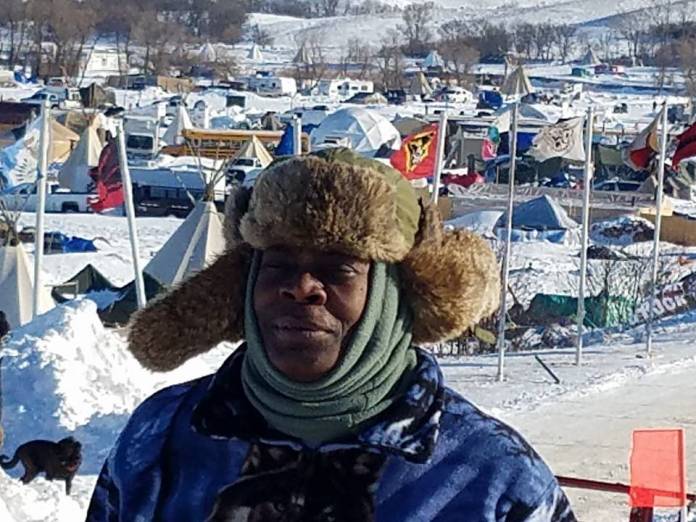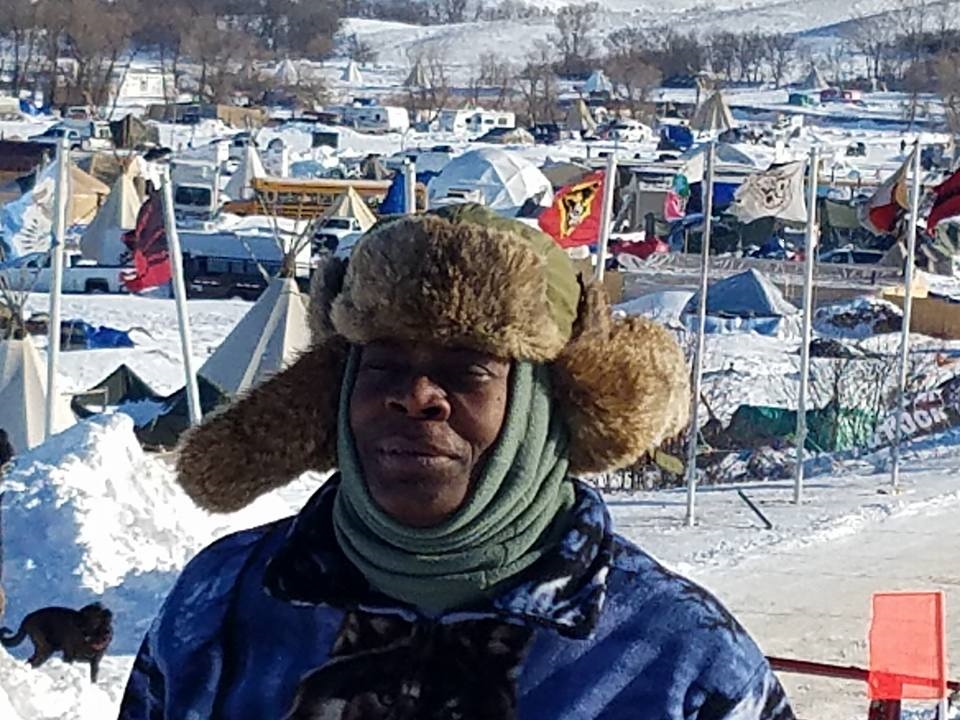
Each step a prayer, through snow so deep your body can’t think. Sharp blue sky filled with whispers from ancestors, a river so sacred it spoke.

We had arrived, at the sacred Oceti Sakowin. Our small delegation of youth and adult poverty skolaz, as we call ourselves at POOR Magazine, representing the Ohlone villages of Huchuin (Oakland) and Yelamu (San Francisco), educated in life, the streets and struggle, not the akademik institutions, journeyed to Standing Rock, North Dakota to bring our humble form of prayer, our stories, love, support, poor and indigenous people-led media to the prayerful encampment of many First Nations Peoples at Standing Rock that has been alive since April of 2016 to pray for water.
We were also there to take back lessons for all of us unhoused and formerly unhoused folks trying to liberate land in the Bay Area, trying to live without more desecration and destruction in projects like homefulness, the Self-Help Hunger Program and Qilumbo. This was a journey of connected liberation for all of us.
Mni Wiconi – Mni WICONIIIIIII! Water is Life — WATER IS LIFE!!!! The calls for liberation of our water of our Mama Earth rang through the sky every day, from dawn to late in the night, the prayers embraced, held and lifted everything, even the resistance.
“This prayer is for us all, for all of our water from the four-leggeds to the winged-ones,” said the elder First Nations mama prayer-bringers as we walked through the deep snow in the daily morning prayer ceremony for water down at the vast silence and soft beauty that is the sacred river that lined the camp.
For five days, our small delegation prayed, learned, and manifested this dream alongside so many dedicated water protectors. From the supplies tent, where you got all your warm clothes and supplies needs met on a donations-only system, to the compost toilet, staffed 24 hours, 7 days a week by two volunteers to keep the toilets clean, shiny and warm, we were overwhelmed with the lessons.
“It’s either one or two scoops of sawdust based on what you need to do in the bathroom,” that night’s bathroom attendant said, taking us though the intricate process of cleaning, compost bag changing and sawdust covering in the beautifully clean and warm compost toilet. It wasn’t just a toilet, it was a toilet center. Like a community center to pee and poo. She went on to explain that they slice in half a pool toy and line the top of the bucket and then put a toilet seat on top of that and then line the bucket with a compost bag and voila — you have a toilet.
“We are serving pozole tonite,” the “mess Hall” kitchen attendant spoke while she ladeled fresh cooked pozole — a soup common to many parts of Central and South Turtle Island. Throughout the camp there were several kitchens, each one with its own flavor, prayer, and love. The food would come in as donations and be cooked with loving hands by folks who stepped up to the task. At our own Two Spirit camp, everyone traded off to create three daily meals of wonder, hot coffee, and hot water for tea.
The housing for this beautiful community of protectors was a threaded network of tipis, tents, tarpees, and yurts, winding though each camp. Our delegations housing inside the Two Spirit camp launched by indigenous youth leader Candy and other comrades was a tarpee, kept warm by a wood stove made out of a recycled garbage can with a recycled drain pipe leading up to the tarpee’s roof. When baking or roasting needed to happen, a garbage can was filled half way with charcoal or wood and a grill was placed on top, with bricks placed below to lift it slightly above the ground.
There were so many lessons for us landless peoples struggling to get ourselves housed on liberated land. How do we un-learn ourselves off stolen land resource hoarding and depending, while still barely able to feed ourselves? How do we secure roofs when we have no paper trail access or bankkkster credit. How do we liberate our water and energy from the grid of blood-stained dollars.
The message from ancestors from Yucatan in the lands of police murdered indigenous father, husband, son and brother Luis Demetrio Gongora Pat and the water protectors at Standing Rock is to realize this dream of truly off-grid living at Homefulness, our homeless peoples’ solution to Homelessness. This will take more time and will not be easy, because it actually takes resources to not use resources, but we have planned that from the beginning and these prayerful journeys reminded us of this important work.
Kuf kuff… kaaarghkuff kuff — the low and long gurgle of a painful cough came from all sides of our small tent, and for this this asthma survivor it sounded like an asthma cough but it wasn’t. My heart clutched in pain every time I heard it, knowing that respiratory pain so deeply.
“We aren’t sure what it is, it has been happening since the attack by DAPL of our water protectors, we think it’s just the combination of dehydration, wood smoke and and extreme cold, but we aren’t sure,” said Samantha, a medic at the powerful decolonized medic compound at Standing Rock.
The cough and the revolutionary medics were a perfect metaphor for the hard medicine and the complex struggle of this small town of more than 2000 people who made up the Oceti Sakowin Camp at Standing Rock.
“We are here to share our knowledge about arctic survival,” said Lasse-Ivvara Erke (he said his “paper” name is Erik) as he spoke to us replete in deerskin pants, a felt jacket and a strangely small hat topped off with a red pom pom. He explained to us that he was from the Saami people of the Northern Hemisphere and his sacred indigenous territory in the Northern Hemisphere was being impacted by the same things that indigenous leaders at Standing Rock were fighting against.
“Some of the countries have signed on to the land protection agreements but many have not, so we face increased climate destruction of our lands,” concluded Erik.
“We are walking from Saskatchewan to Standing Rock to lend support to water protectors but also to shed light on the struggle we face with corporations ready to drill in our sacred lands as well, Ricky a youth indigenous leader from Canada, spoke with us in the “dome” before he went to join other youth leaders on the walk from Saskatchewan.
As our little group wound around the ice-filled roads at 11pm on Gregorian New Years’ evening 2016, in a caravan of horses, pick-up trucks filled with young indigenous peoples and flags from all nations headed towards the sacred grounds of Lakota ancestors the lights appeared from the distance.
We were met with the warring signs of the 21st century cavalry — flood lights, scopes from guns, snowmobiles filled with armed agents. We were on the sacred river, the burial ground of First Nations ancestors but according to the land-stealers and water destroyers we were trespassing. Trespassing!!!
And then suddenly our group was scaling the sacred mountain, heading toward the barbed wire and floodlights. Headed towards the frontlines. Myself, Tiburcio and Aselah couldn’t hold ourselves back; suddenly we were up there. At the top. Putting down prayers. Holding our ancestors close. Dreaming that we weren’t being pointed at with a high powered rifle. Dreaming back All Our Relations.
“We are still here, we are still in this powerful prayer for our water, for our life.” Our small delegation reunited with beautiful revolutionary brother Edwin Lindo who took us to the center of the camp, the most important ceremony we had the blessing to be part of, a ceremony for Wounded Knee
Our last day in this sacred place was spent in the ceremony for Wounded Knee ancestors, in prayer and clarity that these colonizer holidays like New Years, launched in 1904, 13 years after the Wounded Knee massacre were just a way to celebrate the massacre, genocide and land theft of people and Mama Earth. It was in this prayer that we were so clearly reminded that our liberation, our walk to self-determination, and our collective interdependence were so important. That our dreams and work to unhinge ourselves from the pain and exploitation of colonization is everything we are doing at Homefulness. It is everything we as poor and unhoused people need to do. It is our work. It is our resistance.

